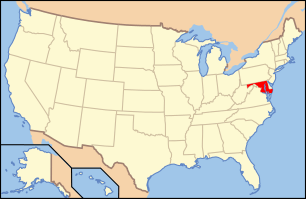Whittaker Chambers Farm
|
Whitakker Chambers Farm | |
  | |
| Location | East Saw Mill Rd., Westminster, Maryland |
|---|---|
| Coordinates | 39°39′35″N 76°58′35″W / 39.65972°N 76.97639°WCoordinates: 39°39′35″N 76°58′35″W / 39.65972°N 76.97639°W |
| Area | 390 acres (1.6 km2) |
| Built | 1941 |
| Architect | Unknown |
| Architectural style | No Style Listed |
| NRHP Reference # | 88001824 |
| Significant dates | |
| Added to NRHP | May 17, 1988[1] |
| Designated NHLD | May 17, 1988[2] |
The Whittaker Chambers Farm, also known as Pipe Creek Farm, was the home "of Whittaker Chambers, an ex-Communist whose revelations about his past espionage activities with Alger Hiss, a former State Department official, had major political repercussions after World War II. Here Chambers turned over the "Pumpkin Papers"[3] implicating Hiss and later wrote 'Witness,' his best-selling autobiography."[2] It was declared a National Historic Landmark in 1988.[2][4] According to the National Park Service it remains the "private property" of the Whittaker Chambers Family and is "not open to the public."[5]
Circumstances
The landmarking of the site was unusual at the time for two reasons. First, it did not pass a usual requirement of 50 years' age for a historic event. Second, the National Park System Advisory Board recommended against its designation.[6] In 1988, Interior Secretary Donald P. Hodel granted national landmark status to the Pipe Creek Farm.[7]
Description
The farm comprises three contiguous areas, separately purchased and separately owned.
The first, a 40 acres (16 ha) site, was purchased by Chambers in 1941 and sold in 1957 to an architect who built the present house in 1960, replacing the house (which had been damaged by fire) that was Chambers' primary residence from 1941 to 1957. The original barn and other outbuildings from Chambers' ownership remain. The Chambers pumpkin patch has been obliterated.[8]
The second property, Pipe Creek Farm, comprises about 230 acres (93 ha), the center of which was purchased by Chambers, and which has remained in the Chambers family. The mid-19th century house on this property was Chambers' residence from 1957 to his death in 1961. The property includes a barn, a pond and several outbuildings.[8]
A third tract of 120 acres (49 ha) was purchased by Chambers in 1947 and was inherited by his daughter, Ellen Chambers Into. The land lies between the first two properties. The house, known as "Medfield", was built in the 19th century and was used by Chambers as a writing retreat. Chambers added a connection between the main house and an adjoining summer house in the 1950s.[8]
A more recent NPS document describes the landmark as follows:
Whittaker Chambers Farm, Carroll County, Maryland (designated on May 17, 1988): Also known as Pipe Creek Farm, this was the home of the former Communist who played a key role in the conviction for perjury of Alger Hiss, a State Department official who attempted to pass secrets to the Soviet Union. Most famously, Hiss gave Chambers documents on a roll of microfilm that Chambers concealed in a hollowed-out pumpkin in the pumpkin patch on the farm; the documents became known as "The Pumpkin Papers" when Chambers turned them over to the House Un-American Activities Committee in 1948. The farm is private property, not open to the public.[5]
Threats
The proposed Union Mills reservoir, if built, may flood portions of the Chambers property close to Pipe Creek.[9]
A fire destroyed the barn and damaged a shed on John Chambers' property on April 30, 2007.[10]
In 2012, an academic published a book on the Cold War which questioned the propriety of the farm as landmark.[11] A member of the Chambers family replied, explaining that the farm is not a museum at all and in fact is not even open to the public.[12][13]
References
- ↑ National Park Service (2008-04-15). "National Register Information System". National Register of Historic Places. National Park Service.
- 1 2 3 "Whitakker Chambers Farm". National Historic Landmark summary listing. National Park Service. Retrieved 2008-06-09.
- ↑ "Pumpkin Papers". WhittakerChambers.org. Retrieved September 4, 2009.
- ↑ Barry Mackintosh (January 26, 1988). "National Register of Historic Places Inventory-Nomination: Whitakker Chambers Farm" (pdf). National Park Service.
- 1 2 Salmon, John S. (October 2011). "Protecting America: Cold War Defensive Sites (A National Historical Landmark Theme Study)" (PDF). National Park Service. p. 68. Retrieved 19 October 2012.
- ↑ "Whittaker Chambers's Farm Is Proposed for Landmark". The New York Times. March 21, 1988. Retrieved September 3, 2009.
- ↑ "Site in Hiss-Chambers Case Now a Landmark". The New York Times. May 18, 1988. Retrieved June 9, 2008.
- 1 2 3 Mackintosh, Barry (January 26, 1988). "National Register of Historic Places Inventory - Nomination Form: Whittaker Chambers Farm" (PDF). National Park Service. Retrieved 2009-03-20.
- ↑ "Planned Union Mills Reservoir" (PDF). Carroll County Bureau of Comprehensive Planning. December 31, 2006. Retrieved 2009-03-20.
- ↑ Riordan, Penny (May 1, 2007). "Fire causes damage at historic farm". Carroll County Times. Retrieved 2009-03-20.
- ↑ Wiener, Jon (October 13, 2012). "A visit to the right's least popular museum". Salon.com. Retrieved 19 October 2012.
- ↑ Chambers, David (October 18, 2012). "Whittaker Chambers relative: Farm need not be open to public". Salon.com. Retrieved 19 October 2012.
- ↑ Chambers, David (October 19, 2012). "Salon.com debate on Whittaker Chambers Farm". WhittakerChambers.org. Retrieved 19 October 2012.
External links
- Whittaker Chambers Farm, Carroll County, including photo in 2003, at Maryland Historical Trust
- WhittakerChambers.org
- http://www.savewhittakerchambersfarm.org/
- INK "Writings of Whitaker Chambers", broadcast from Whittaker Chambers Farm from C-SPAN's American Writers

